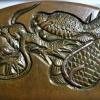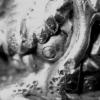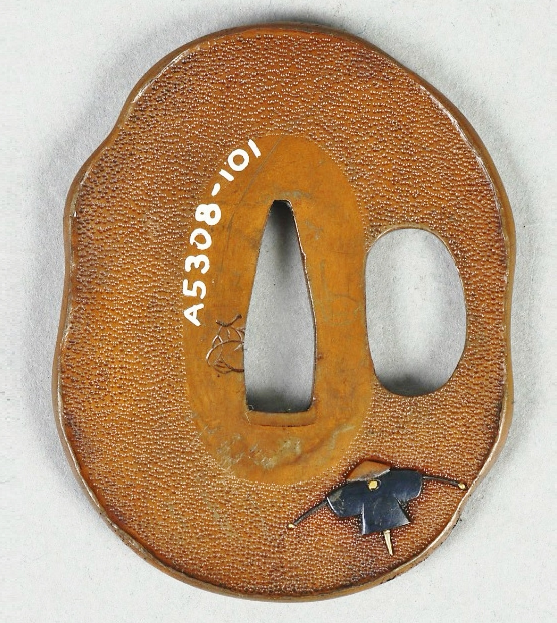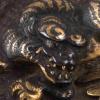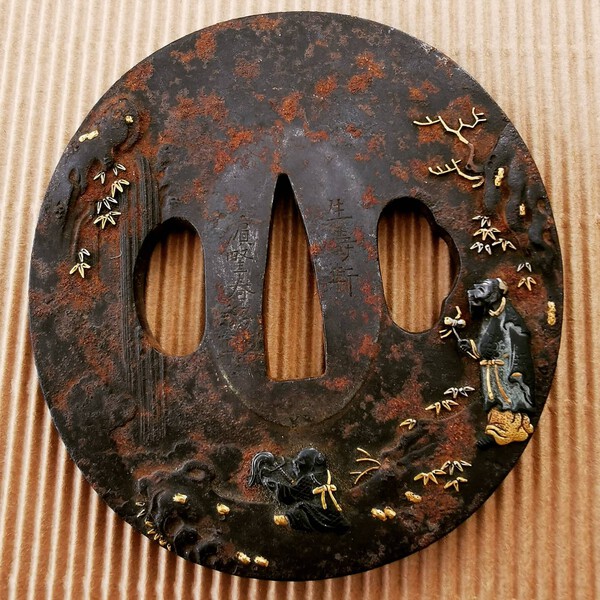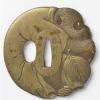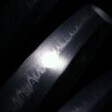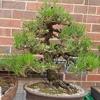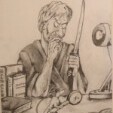Leaderboard
Popular Content
Showing content with the highest reputation on 09/17/2020 in all areas
-
4 points
-
I have to make a coment on the voracity of museum descriptions and how we should not blindly follow their interpretations. The McLean Museum and Art Gallery - Interclyde council [Scotland], has a rather unusual tsuba in its collection. "The tsuba is in the form of a rack holding a Japanese robe and hat, in gilded relief. There is gilding on both faces. Inscription one face. Signed: Shigeyoshi Umetada." [1981.134] The Powerhouse/Museum of Applied Arts [Australia] has this as the ura side of a guard. The description has this "The reverse of the tsuba has a relief of a shirt on a hanging implement." [A5308-101] The final image will give you a clue as to what both guards are in fact representing. A childs balance toy. What is more damning of the description by the Powerhouse museum, is the fact that two toys are represented on the omote side.2 points
-
2 points
-
2 points
-
Hello, I just got interesting tsuba from conservation (few pictures now and before). It is signed "Seijuken Hamano Haruyoshi" and it is made of iron. I found almost identcal one made of shakudo sold at Sothebys. http://www.sothebys.com/en/auctions/ecatalogue/2005/Japanese-works-of-art-prints-and-paintings-l05861/lot.1017.html They are almost identical in design. Tree on the front side in right upper corner has the same coposition of gold and copper inlay. Based on that I assume that maker of the iron one had the one from Sothebys in hand. As far as I can say inlay is made of solid gold. So this was not meant to be cheap replica. Just found and iron one in Choshuya: https://www.choshuya.co.jp/senrigan/李白観瀑図鐔 銘 -生壽軒濱野春好(花押)/鍔/春好(花押)?lang=en I wonder what are your thoughts abut it. Regards, Krystian1 point
-
You are not typing your posts directly. You are cutting and pasting from somewhere, right? And pasting as rich text, which keeps the font colour....black. On the dark theme, they can't read it. If you type directly, or paste as plain text (you'll see the option when you paste) then the forum software will automatically adjust font colour.1 point
-
That's some good detective work on the fuchi/tsuka fit, Chris! I knew the tsuka didn't align with the saya, and you found why! With your collage, I do see a faint hamon, though. Likely oil quenched.1 point
-
1 point
-
1 point
-
Hello, they sent me documents in French : ►First one is just about the signature ►Second : This sword was made by the armorer BIZEN OSAFUNE in the year 2 of the Oei era. (538 years ago, i.e. 1394 CE) A renowned performer in the city sabers himself as an artistic masterpiece and practical value OSAFUNE is a city name[...] Saber having nearly 540 years is of great value by its original form preserved intact. The gold ornament was made around the Genroku era (250 years ago) ►Last one : born Marie Josephe .... MEYER born 25th of January of 1908 in Duisans Widow of Mr René Henri Robinet born 16th of February of 1905 in Toul Sword acquired from the 5th of General Claudel (gift of the Emperor of Japan at the beginning of the century to General Claudel.) [adress of mr Robinet]1 point
-
JP, He explained in post 12 that by "stamp" he meant single-steel, machine rolled and cut. Troy, If this sword had been brought to us from an auction buyer, who didn't know it's story, we would all have assumed it was a post-war piece-together. It is done sometimes by collectors and sellers trying to make an easy buck from unsuspecting newbie collectors. But you have, at least for now, a more solid story on the sword. Without more details, though, it's still just as possible he obtained the sword after the war. If so, or even if it was during the occupation, this appears to have been put together from available parts to make a souvenir. You have some interesting parts, though. The tsuka is really nice quality. I put the tsuba to the Translation Assistance guys, READ ABOUT IT HERE. You will see that the craftsman, Mitsunaga, made several of these, but they are likely made cheaply, possibly for tourists, which supports the idea this sword was constructed as a souvenir. Which is why it would be interesting to find out if your uncle served during the post-war occupation. Japanese craftsmen were selling such items after the war, just trying to put food on the table and survive. As such, your sword would still be a valuable piece of Japanese war history, in my opinion.1 point
-
I have a split reaction on this one. On the one hand throughout the Taisho and early Showa all major Daimyo collections published more or less complete representation of what they had, and such tachi as in the video above are there in the sales catalogue of Satsuma, they are in Owari Tokugawa collection, they are in Marquis Kuroda exhibition etc. etc. All are curved, unlike the original type, because they don't house special parade blades but more like national treasures from Heian and Kamakura periods. With mounts of gold or in the very least quality gilding. Covered with personal family mons, high class nanako, top class makie. These are probably the most gold-burning items you find in these collections. I don't see anything suggesting these mounts were somehow adopted to some specific standard corresponding to a specific kuge rank. Promotion within court ranks was a norm, were there a need to receive a new set of mounts to mark it, we would first find all the mounts for different ranks in such collections, and more likely gilded than pure gold. But that's not we find there - we see just very few top class mounts with artificially "ancient appearance" and that's it. Parade blades of weird shape is also just not something we see in the Edo period, and nakago here is quite telling. In marriage gift requests there were records for what is being assumed somewhat expensive mounts with the blades whose price suggests its a tsunagi of sorts. I sort of assumed those were just good mounts for circumstances when the blade is of no consequence, but... Kirill R.1 point
-
I think a new "Nakago" has been welded on to keep the blade length as it was. I have seen this done with a rat tail tang blade to make it "usable". We need to know more of the swords history to make sense of it.1 point
-
I'm not 100% confident that it is indeed 写 (or 寫) but the single kanji coming after the kao is pretty unique. I don't think its a name. I thought the kao would be the actual smith's kao, and 写 would be his acknowledgement that the blade was an attempt at emulating a certain style or another smith.1 point
-
1 point
-
It was stabilized with alcohol and tannin. So I hope it won't but I do not have long time experince to be certain that this method will work.1 point
-
I also think the blade is in a very good condition. Rob, sorry but I cannot opine on the koshirae here and how old it is. Kirill, in a separate post about your kazari tachi, was opining on the size and colour of the gold flecks. Not sure to what extent those statements are borne out by fact and study. However, I have heard elsewhere, too, that the gold used more recently is indeed brighter and yellower as opposed to more tinted in the past. However, one need not forget that the lacquer layers on top also affect the colour. it could be that the koshirae was made to order for the imperial gift and is this only 100 years old or it could be it is 250 years old. Indeed one would need to examine properly the nanako, the gilding, the gold flakes etc etc.1 point
-
In a sword fight anything can happen so it could very easily be fight damage. Its not like in the movies where its all choreographed. Tsuba are mainly for protecting the hand from sliding up onto the blade and from an enemies blade but there would be countless times tsuba were hit by blades producing these type of scars.1 point
-
We had a club meeting there and tools them again. Still no change. I haven't been back for a few years ago it may have been corrected. Their best sword a Shodai Hizen Tadakuni with a two body cutting test is the one wrongly labelled.1 point
-
1 point
-
Seems to be a mix of designs. I see some US Starr in there, Belgian pinfire design, Colt style grips and the loading lever is Adams/Tranter style. Very innovative.1 point
-
Dear All Thank you to all those who took the trouble to have a go at this exercise. It wasn’t intended as a competition it was an attempt to get people thinking about what we are told and how we apply it. Two things virtually all books tell us: Shape indicates age. Look and understand the shape before you look at anything else. In a perfect world these represent good advice, however once a sword is modified looking at the shape is not enough. I was impressed that nearly everyone was hovering around the right answers, some slightly better than others. If I was awarding prizes (which I am not) I think it would have to go to Arnold who was pretty well there or there abouts on all counts. The answers: Shin-Shinto (1860s) Momoyama more specifically Tensho (1578-1590) Late Kamakura (1320-1330) Early to mid Kamakura (1215-1220) Explanation: An ubu Mumei Katana papered to Hosakawa Tadamasa of the 1860s. It is a Yamashiro/Enju lookalike with beautiful jigane and a ko-nie hamon. Without the luxury of the paper my first guess on this would have been Hizen based on an ageless elegant shape and the tight hada. The NTHK papered it but to be honest I am still trying to understand the attribution to the Hosakawa school although I can understand the dating. An O-suriage katana attributed to O-Kanemichi (Dai-Do) and dated to Tensho. The original shape would have been considerably longer slim and elegant. The hada and hamon clearly show the Mino roots. I have had this sword for many years but to be honest have studied everything but the shape so have taken the papers at face value. If after further research this doesn’t seem right I will come back to you. An O-suriage tachi attribute to Aoe Tsunetsugu and dated to the late Kamakura. I also thought Nambokucho when I first saw it. It is a large sword with an extended chu-kissaki so the nambokucho dating was understandable. However as an Aoe sword if it did date to Nambokucho it would be even bigger ,with an O-kissaki. More importantly the hamon would be nioi based, a lot more flamboyant and there would be shirrake utsuri. In this case the blade has a ko-nie deki hamon a huge amount of ji-nie and jifu (I know you can’t see it in the images but bear with me) The other real clincher is the turn back on the boshi is very sharp and according to the papers this is a strong indicator of Kamakura period Aoe workmanship. A Kamakura period Tachi attributed to the Awataguchi smith Norikuni who was working circa 1215-1222 so depending on where you choose to draw the line early or mid Kamakura. This is a classic early Yamashiro shape or would have been prior to shortening. Even in its shortened state there is evidence of slight fumbari and it is just koshi-zori. Equally important and indicative of very early swords is the straightness almost appearing as uchi-zori in the last 10-20cm of the blade. I have seen this feature on a high proportion of older blades and personally think it is a good indicator of age when the more obvious features at the other end have been removed. I think if there is any conclusion to be drawn from this small exercise it is that looking at one element of a sword is never enough you have to look at it as a whole and reach a conclusion on how the different elements work together. Having said that the results here also indicate that starting with the shape can put you very close to where you want to be and can at least reduce the search a little. Unfortunately it is one feature of the blade that we are inclined to ignore as we search hungrily for details of hamon and hada to determine who made something and when.1 point

